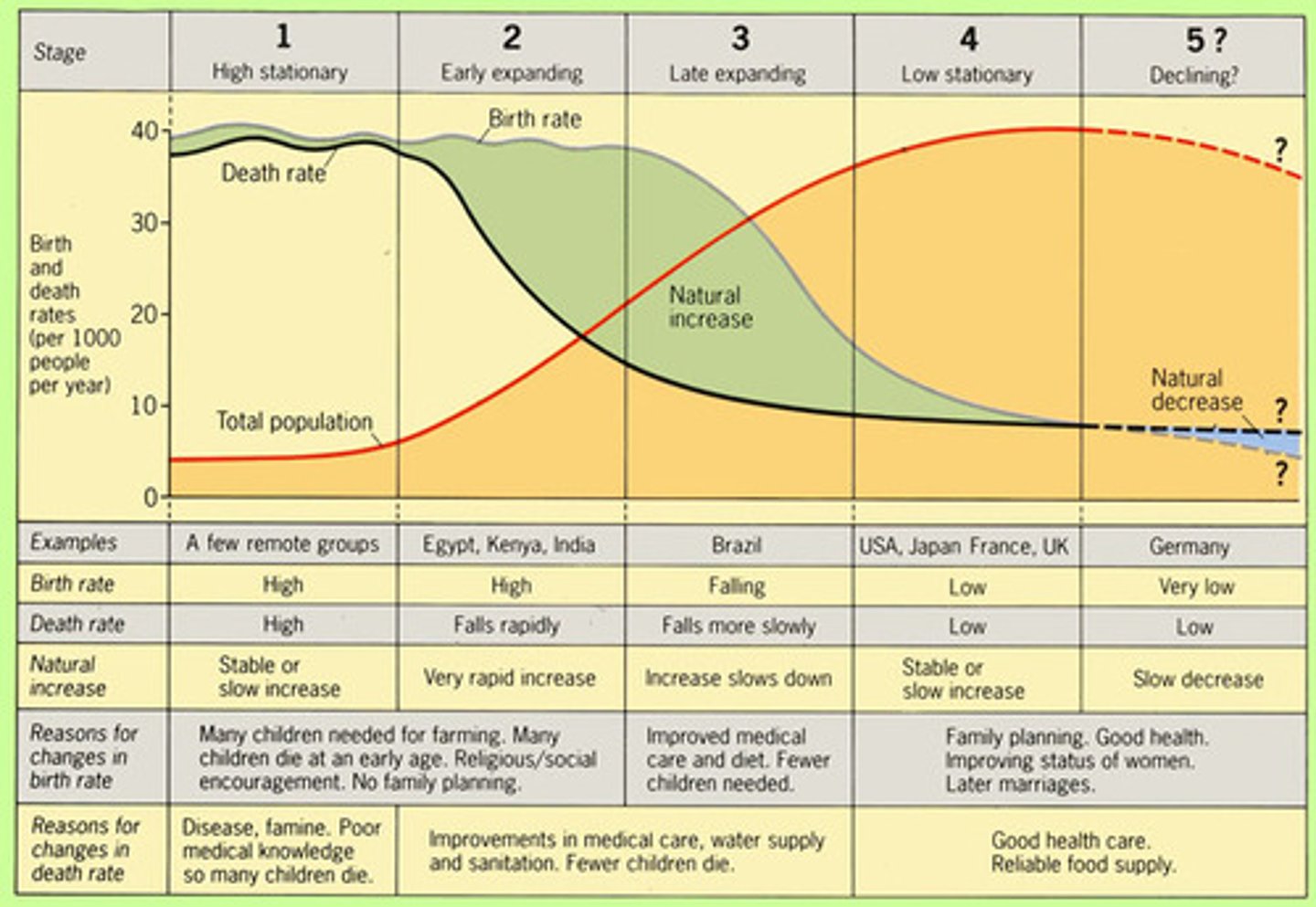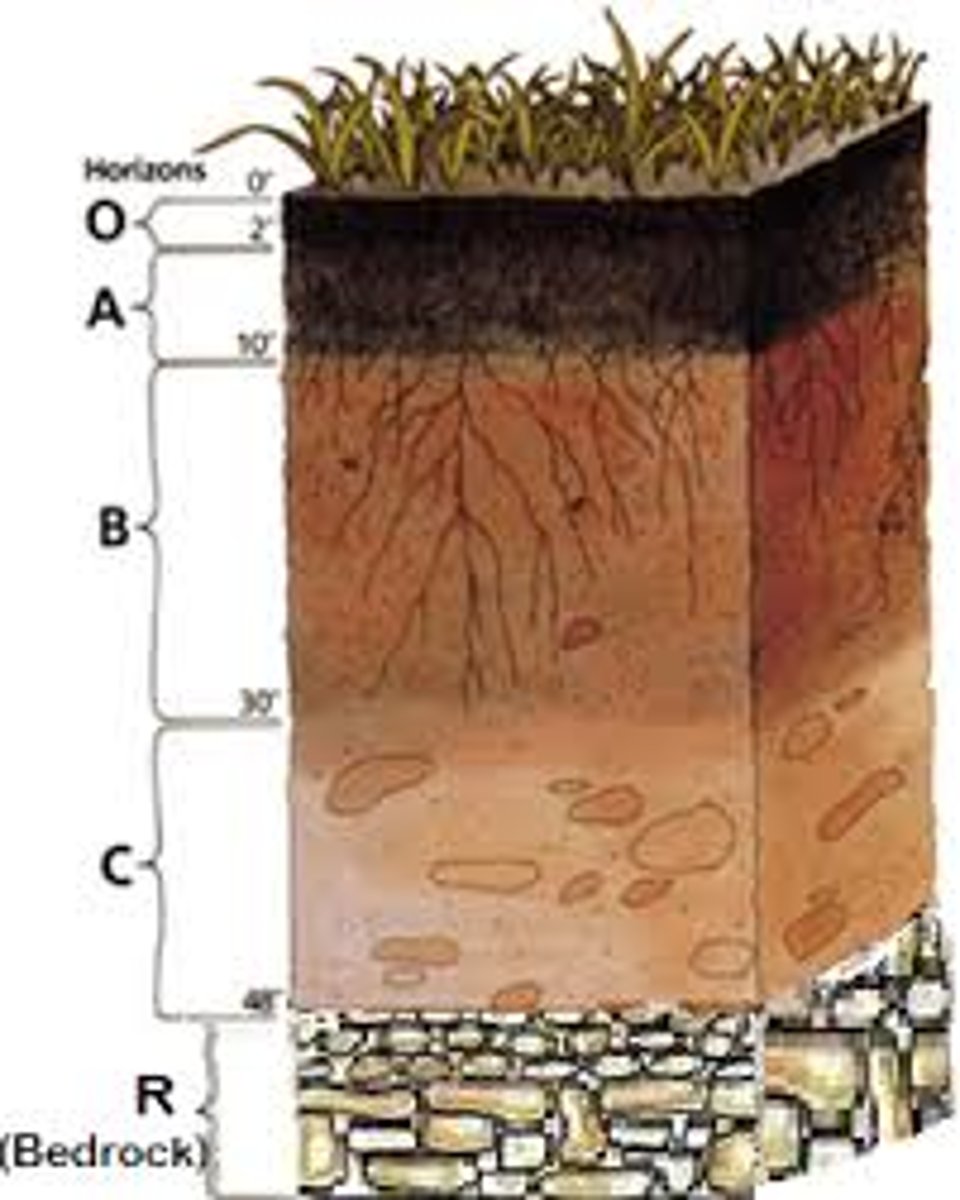Population and Environment - Case Studies
1/35
There's no tags or description
Looks like no tags are added yet.
Name | Mastery | Learn | Test | Matching | Spaced |
|---|
No study sessions yet.
36 Terms
Population change in Bangladesh
Bangladesh is overpopulated, with 1350 people/km sq. It has a population of 173 million which is largely all on low lying river delta (prone to flooding). Bangladesh is just half the size of the UK, it is low lying, flat as well as hot and wet climate. Its fertile river delta floodplain are ideal for rice production.
Population change in Bangladesh Part 2
Declining fertility rate of 2.2 due to educated women starting careers as well as widespread use of contraception. However, improvements in healthcare mean life expectancy has increased to 73 years, from 50 years in 1970.
Social consequences of population change in Bangladesh
Slums as large as 200,000 people due to rural-urban migration. Poor-quality housing and lack of basic services lead to inequality gap. Sanitation systems haven't kept up with population growth, only 18% of Dhaka has a sewer system.
Economic consequences of population change in Bangladesh
Falling dependency ratio means Bangladesh is now experiencing the economic benefits of a demographic dividend. High level of emigration means Bangladesh gets $12 billion a year in remittance payments however some emigrants leave Bangladesh permanently which leads to lack of doctors, engineers etc
Environmental consequences of population change in Bangladesh
Only 11% of Bangladesh is forested, leading to increased soil erosion. Clearance of coastal mangroves leads to flooding and coastal erosion and soil salination. Intensive farming requiring fertilisers has increased water pollution due to agricultural runoff. Dhaka air pollution is over 8 times higher than recommended air quality, more than 120,000 deaths due to PM2.5 (air particulates)
Demographic Transition Model
Model explaining the shift in population growth rates globally. Stage 1 shows high birth and death rates, stage 2 shows falling death rate, stage 3 is when birth rate begins to fall, while population continues to undergo natural increase. Stage 4 is where most developed countries are, with a small natural increase. Stage 5 is where Japan is, it is when a country begins to experience a natural decrease and rapidly ageing population. A limitation of the DTM is that it neglects migrations effect on a population e.g. Germany would definitely be in stage 5 without migration but due to the large net immigration to Germany, its population hasn't fallen as much as it would have without migration.

Semi-arid (e.g. Sahel)
Between the Tropics of Cancer and Capricorn. Savanna vegetation, tall grasses and woody trees. Rainfall is between 250-500mm/year. Unreliable crops due to climate, crops that are grown include millet, cowpea, cotton. Pastoral agriculture occurs, nomadic and rainfed due to lack of development in Sahel countries.

Semi-arid (e.g. Sahel) climate change
Population growth is outstripping any increases in crop yields. Climate change is making rainfall less predictable and extreme temperatures to be more common, famine is made more common with climate change.
Mediterranean
Between 30 and 45 degrees north in latitude.
Small, drought resistant, vegetation (Thorny bushes, shrubs and small trees). Summers are warm/hot and dry. Winters are mild/cold and wet. 300-1000mm rainfall per year. Intensive viticulture. Pastoral farming is rare due to sparse grass and shallow grass roots. Farming is currently reliable, and food security is good.

Mediterranean climate change
High tourism pressures land and resources. Mediterranean Sea is warming due to climate change. Aquifers cannot be replenished over the winter due to unreliable rainfall and extreme temperatures, this makes viticulture more difficult and has negatively affected the Mediterranean's food security.
Podsols
A type of soil found in the Scottish Highlands and Scandinavia. Most nutrients are found at the top of the soil due to a slow rate of decomposition as a result of the low temperature in these regions. Podsols are not suitable for crops due to low pH (acidic) and therefore is used as forestry. Soil depth is rarely over 1 meter. Fertiliser and lime can be added to raise pH and make the soil more suitable to crop production, however this has adverse effects on local ecosystems due to the introduction of fertiliser.
Soil Horizons
O Horizon (Organic Layer): Mainly decomposing plant and animal material, this layer is critical for nutrient recycling.
A Horizon (Topsoil): This layer is richest in organic material and is the primary zone for plant root activity and microbial life.
B Horizon (Subsoil): Characterized by mineral accumulation and signs of leaching, this layer has less organic matter than the A horizon.
C Horizon (Weathered Parent Material): Comprised of weathered parent rock, this layer indicates the geological and mineralogical history of the soil. The R horizon is bedrock/parent material

Ferralsols
A type of soil found in the tropical regions of South America and parts of Africa. High rainfall leads to leaching of the soils nutrients. Rainforest vegetation sheds its leaves all year round which decomposes rapidly, supplying nutrients to support sustainable growth quickly. Clearance of vegetation removes most of soil's nutrients.
Ethiopia's food security
Ethiopia has 15.8 million people in need of food assistance in 2024. This is because of sustained soil erosion, conflict, monoculture, deforestation and droughts. NGOs and international aid is aiming to prevent this crisis from worsening.
Air pollution in China
Millions of people in China die from heart, lung and strokes related to air pollution. China still burns a lot of coal to heat homes (especially in the winter) and generate electricity, this causes dirty air build up. 38% of China's population live in an area with a long-term air quality labelled 'Unhealthy'.
Malaria
Malaria is spread by infected female mosquitos when they bite humans, the human gets a liver infection and infected blood cells, when the next mosquito bites this human, the mosquito gets these infected blood cells, the next human to be bitten by this mosquito then gets these infected blood cells. This causes the human to have a high temperature, sweats and chills, headaches, tiredness, diarrhoea, aches. If left untreated malaria can be fatal. Malaria is prevalent in Africa, SE Asia.
Malaria part 2
90% of 200m cases in 2015 worldwide were in Africa, mainly in the Congo basin and West Africa.
Health education, bed nets, faster diagnosis, and cash payments to the poorest in society are steps taken to reduce its spread
Asthma
"Chronic disease characterized by recurrent attacks of breathlessness and wheezing"-WHO
Child asthma rates are highest in the USA, UK, Australia and Latin America.
WHO noted that "most asthma-related deaths occured in low and middle-income countries"
Asthma's triggers
The overall risk of developing asthma comes from environmental factors:
Air pollution, Smoking, Obesity, Indoor allergens, Pollen, Cold air. Family history also dictates the risk of developing asthma
Asthma in the USA
1 in 14 Americans suffer with asthma. Since the 1980s, Asthma has increased in all age, sex and racial groups. African Americans have a 3x chance of hospital stay because of asthma and 3x higher death rate due to asthma. This can be explained by the inequality between racial groups as African Africans on average have poor urban air quality, inadequate medical care and poverty
Asthma prevention
Avoiding triggers, taking medication (inhalers contain asthma drug Salbutamol). NGOs and Intl agencies, such as WHO and Global Asthma Network, are researching the cause of asthma and factors affecting its triggers.
NGOs and international governmental aid departments
World Health Organisation (WHO)- provided leadership, research and support on global health and disease
The Bill and Melinda Gates Foundation- richest charity in the world, promotes eradicating poverty, improving health by using research and disease prevention
NGOs and international governmental aid departments .Part 2
Governmental aid departments- most countries (HICs in particular) have aid departments which send aid to countries in need.
Red Cross (Red crescent in Muslim countries)- Deals with humanitarian crisis, e.g. Gaza conflict
Oxfam- Aims to eridicate poverty, provided sanitation and water to crisis victims
Health in Knowsley/Liverpool City Region
Knowsley is part of the Liverpool City Region in the North-West of England. Over 27% of homes failed to meet the Decent Homes Standard in 2011 leading to premature deaths from poor insulation leading to cold and damp conditions. Few people use the open spaces in Knowsley for exercise, instead 30% of population smoke (20% UK avg.) This further leads to obesity and subsequently working age people out of work (7.7% compared to 5.3% UK avg.). Income in Knowsley (£475) is lower than UK avg (£539) partly due to lack of qualifications (25% of 16-64s don't have any qualifications compared to 15% UK avg)
Population change
Africa is projected to double in population from 2010 to 2050 (to 2 billion).
Asia's population doubled from 1975 to 2025 (to 4.8 billion)
Europe's population has remained constant at roughly 700 million.
World population is still increasing (currently 8b, projected 9.1b by 2050) but at a slower rate than from 1950-2000 (from 2.5b to 6.2b)
Population theories
The Malthusian theory on population is the idea that the rapid population growth that comes with industrialising (e.g. industrial revolution in 1800s) will outstrip the world's resources and war and famine will inevitably occur as a result.
Boserup theorised that as population increases, human's will innovate and invent and thus relieve the pressure on resources.
Club of Rome suggests that the world cannot support current economic and population growth after 2100, we need to change growth rates to prevent famine etc.
Population Pyramids
A population pyramid is a pyramid split into two halves with the left half being for the male population and the right half for the female population. Each horizontal bar represents a certain age group, often with a class width of 5 years. The width of the bar represents the proportion of the total population that group makes up e.g. the 0-5 years old group makes up 5% of the total population of the country.

Fertility rate
If the average fertility rate in a country is 2.1, then the population is thought to remain as 2 children will replace their parents and the 0.1 accounts for child mortality.
Countries such as Niger have a fertility rate of 6.8 while South Korea has a fertility rate of 0.72.
Demographic dividend
Economic growth brought on by a change in the age structure of a country's population. The first demographic dividend is when fertility rate falls when a country develops from a rural economy, this fall in fertility rate means that the labour force grows faster than the population depending on it therefore GDP/capita increases
Second demographic dividend
When the large labour force starts to retire, they start to accumulate more assets e.g. houses, cars. These assets increase the national income.
Polish migrants to the UK
Poland joined the EU in 2004, when its unemployment rate was 20% and salaries were much lower than UK average. 600,000 Poles migrated to the UK, mostly within the first few years of Poland's EU membership, most were attracted by the higher wages available, better conditions and quality of life.
Polish migrants to the UK .Part 2
Peterborough is a hotspot for Polish migrants as there are many food picking jobs available that Britons are unwilling to do as well as an established Polish community. However, Poland co-hosted Euro 2012 and struggled to find enough construction workers as too many of them had migrated to the UK.
Poland benefits of emigration
Eased pressure on public services. New female opportunities in careers previously dominated by males.
Poland drawbacks of emigration
Depopulation, high-skilled youth emigrated to UK. Poland has the potential to depend on remittance payments. Poland's population has rapidly aged due to emigration of young workers. Job vacancies, such as construction of Euro 2012 stadiums, struggled to be filled due to shortage of workers.
UK benefits of immigration
Cultural diversity. Larger labour force contributes to economic growth, with unskilled labour vacancies e.g. fruit picking, filled by Polish immigrants.
UK drawbacks of immigration
Racial discrimination and increased pressure on the NHS and education services. Some immigrants found work in the informal economy which does not generate tax revenue.